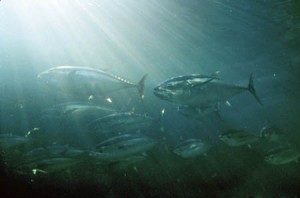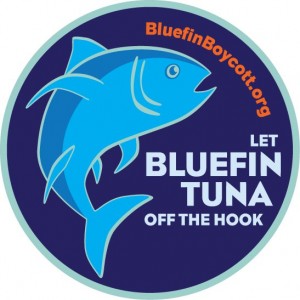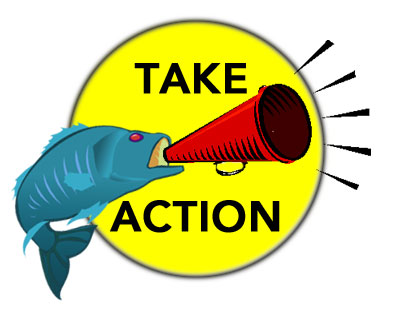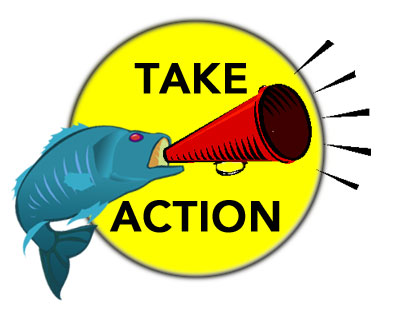 Photo: National Marine Fisheries ServiceCritics of the International Commission for the Conservation of Atlantic Tunas often say that the acronym ICCAT might better stand for the “International Conspiracy to Catch All Tuna.” At its most recent meeting, ICCAT lived up to that derisive nickname by setting 2011 catch levels for Atlantic bluefin tuna (Thunnus thynnus) at basically the same levels as 2010 — 12,900 tons, down from 13,500 — despite the pleas of conservation scientists and the bluefin’s place on the International Union for Conservation of Nature’s “Red List” of endangered or critically endangered species (Western stock and Eastern stock).
Photo: National Marine Fisheries ServiceCritics of the International Commission for the Conservation of Atlantic Tunas often say that the acronym ICCAT might better stand for the “International Conspiracy to Catch All Tuna.” At its most recent meeting, ICCAT lived up to that derisive nickname by setting 2011 catch levels for Atlantic bluefin tuna (Thunnus thynnus) at basically the same levels as 2010 — 12,900 tons, down from 13,500 — despite the pleas of conservation scientists and the bluefin’s place on the International Union for Conservation of Nature’s “Red List” of endangered or critically endangered species (Western stock and Eastern stock).
Soon after the ICCAT decision — or “death sentence,” as a post at Change.org put it — the Center for Biological Diversity announced a “bluefin boycott.”
 Center for Biological DiversityWhile that sounds (and is) good, the Center’s campaign is about far more than simply giving up buying and eating bluefin tuna. After all, Japan consumes about 80 percent of the world’s bluefin catch, so the impact of a U.S. boycott will be limited. That’s one reason the Center’s “boycott” also calls for action by governments and international organizations. (I have written previously about the limits of consumer-based campaigns.)
Center for Biological DiversityWhile that sounds (and is) good, the Center’s campaign is about far more than simply giving up buying and eating bluefin tuna. After all, Japan consumes about 80 percent of the world’s bluefin catch, so the impact of a U.S. boycott will be limited. That’s one reason the Center’s “boycott” also calls for action by governments and international organizations. (I have written previously about the limits of consumer-based campaigns.)
There are a number of critical steps if we want to save this truly remarkable creature — a warm-blooded racer that can swim at top speeds of 40 miles per hour, a migrant that travels thousands of miles a year. One of them is to create a new seafood category to guide consumers, “Take Action.”
Reckless endangerment
The Center’s primary policy goal in the campaign is to convince the National Marine Fisheries Service (NMFS) to protect Atlantic bluefin tuna under the Endangered Species Act. Although the U.S. is a minor player in terms of catching or eating Atlantic bluefin tuna, the primary spawning grounds of the fish’s western population is in U.S. Gulf of Mexico waters.
Here’s how it works. After the NMFS reviews scientific data on the fish’s population trends and habitat, it can define the fish as “endangered” or as “threatened” — or take no action. A definition of “endangered” would essentially shut down the market for Atlantic bluefin tuna in the United States by prohibiting capture, sale, import, and export of the fish in the U.S. A listing might also reduce the trade of other bluefin species, as merchants might not want to take the chance when a vendor shrugs and says, “I’m sure it’s not Atlantic bluefin.” (With just a small sample, DNA analysis can differentiate between the species, as a paper in PLoS ONE illustrated.) Inclusion on the “threatened” list would require federal agencies to take actions to conserve the species but would not affect trade.
The Center detailed the case for a listing in a May 2010 petition to the NMFS [PDF]. The NMFS responded positively to the petition in September 2010, making bluefin tuna a candidate species and starting a status review to determine if a listing is warranted. Details on the action can be found on the bluefin tuna page of the NMFS’s Office of Protected Resources.
Get off your ass alert: To help speed an endangered species listing, the Center recommends writing letters to the National Marine Fisheries Service (*contact information below) and to members of Congress, especially those from New England and members of the Senate Commerce Committee and the House Natural Resources Committee. Writing letters to editors of newspapers and magazines, blogging, and social media tools are essential to spread the word about the campaign. Finally, signing the pledge, asking your favorite restaurants to do the same, and avoiding all tuna sushi are also good ideas.
(Why all tuna sushi? Because even if the server says that the sashimi is bigeye tuna (T. obesus) or another non-bluefin species, you might be inadvertently eating bluefin, as researchers who DNA-analyzed tuna sushi from restaurants in New York and Denver found and reported in PLoS ONE.)
If NMFS refuses to list the Atlantic bluefin tuna, there are still some near-term actions that the NMFS and other U.S. agencies could take to protect bluefin spawning areas, such as restricting long-line fishing for other species of tuna during the bluefin’s spawning period in the Gulf of Mexico. Although NMFS regulations prohibit fishing specifically for bluefin tuna in the Gulf of Mexico, bluefin tuna are caught accidentally by longlines intended for yellowfin tuna and swordfish (a paper in PLoS ONE explores the by-catch situation in the Gulf, among other things; a report by the Pew Environment Group argues for spawning sanctuaries). Off-shore oil platforms are located in the spawning area in places (see Figure 5 of the Center’s petition, PDF) and oil from the BP disaster spread into the spawning area, so better management of oil facilities could also be beneficial to bluefin.
International action will also be needed. With the demonstrated inability of ICCAT to manage the fisheries, the best hope for all bluefin tuna species (the Atlantic, the southern, and the Pacific bluefin tuna) might be a listing by the Convention on International Trade in Endangered Species of Wild Fauna and Flora (CITES), which would create an international ban on trade in the species. When Atlantic bluefin was considered for listing by CITES at the last big meeting in March, there seemed to be momentum for passage — the U.S. government expressed support [PDF] — but Japan and several southern Mediterranean nations blocked the proposal. (A round-up of coverage of the CITES meeting is at the Ethicurean.)
The lesson of swordfish
The Give Swordfish a Break campaign of the late 1990s, which is considered a great success in the sustainable seafood community, is worth looking at as a positive example.
In his superb book Four Fish, Paul Greenberg explores the swordfish campaign as part of the tuna chapter. In 1998, after years of declines in swordfish yields and population, the nonprofit group SeaWeb, in conjunction with the Natural Resources Defense Council, launched the campaign with the endorsements of 27 well-known chefs from the East Coast. Nora Pouillon, Rick Moonen, Eric Ripert, Lidia Bastianich, and others pledged to stop serving Atlantic swordfish during the campaign.
But the campaign was about more than restaurants and home cooks changing their buying habits. “We didn’t want one of those open-ended, never-finished boycotts,” sustainable seafood pioneer Vicki Spruill told Greenberg. Instead, the campaign had a discrete goal: convince the NMFS to close portions of Gulf of Mexico breeding grounds during spawning season so that swordfish could reproduce in peace. In August 2000, the campaign got its way. And in the years since the NMFS’s action, the swordfish population has rebounded, and many are calling the fishery recovered — at reasonable catch rates, of course.
Greenberg writes:
The campaign is a success story in every aspect. A clear goal was identified. An appropriate citizen response was crafted. But it’s worth looking into what really changed the swordfish’s fate. In the end it was not a diminishment in actual swordfish consumed that changed the dynamic but rather strong, unilateral government action. There were probably no fewer swordfish caught and eaten during the time of the campaign than before its launch. Rather, it was the threat of turning swordfish fishing (and perhaps fishing in general) into a pariah that raised media attention and pressured the fisheries service into closing the swordfish’s spawning ground and protecting the long-term viability of the stock.
Returning to the bluefin boycott, will it take off like the swordfish campaign? Will we see legions of star chefs adding their name to the campaign? The restaurant sign-on list contains some heavy hitters already: Chez Panisse, the two Blue Hill restaurants, Bon Appétit Management Company (which operates 400+ cafés for universities and corporations), and a handful of sushi specialists. However, it seems to me that many consider bluefin tuna to be old news — most top seafood restaurants in the U.S. stopped serving the fish a while ago. And as many chefs are too busy running their restaurants to find time to lobby government officials for policy changes, they might think their job is done.
 Turn on the siren
Turn on the siren
The plight of the bluefin tuna and other severely threatened species calls for some new thinking about sustainable seafood lists.
Seafood Watch’s categories of “Best Choices,” “Good Alternatives,” and “Avoid” can be helpful for eaters and chefs who want to support ocean-friendly seafood, but it doesn’t go far enough. For the most imperiled species, I suggest a fourth category: “Take Action.”
To be in this category, which could be indicated by a siren, a fish would need to be at the edge of the endangered species list or on the IUCN’s red list, and a campaign with a clearly defined target would need be in motion.
The “Take Action” list for fish would spell out specific actions for each species. For example, bluefin tuna might have “get added to the U.S. endangered species list and establish a protected area in the Gulf of Mexico during spawning season” and sharks might have “pass legislation prohibiting sale or possession of shark fins in the U.S.” To ensure national coherence, the many groups that create seafood lists would need to coordinate on the “Take Action” species and actions. This is a situation where tools like the Monterey Bay Aquarium’s Seafood Watch app for the iPhone (and someday for Android) can be especially useful, as they can stay updated with new information and direct the user to outside websites for letter writing and so forth.
In addition to the Atlantic bluefin, we must also not forget the other species of bluefin tuna that are also in danger of extinction, southern bluefin tuna (T. maccoyii) and Pacific bluefin tuna (T. orientalis). It will take a remarkable effort to protect the bluefin from destruction by greed and ignorance: an action menu that includes not only voting with our forks, but also confrontational activism (like the campaign against Nobu led by Greenpeace) and agitating for changes in domestic policy and international agreements.
Cross-posted from The Ethicurean
*Contact information for writing to the National Marine Fisheries Service urging that bluefin be added to the endangered species list:
Kimberly Damon-Randall, Endangered Species Coordinator
Office of Protected Resources
NMFS, Northeast Regional Office
55 Great Republic Drive
Gloucester, MA 01930
Agency docket # RIN 0648-XW96



